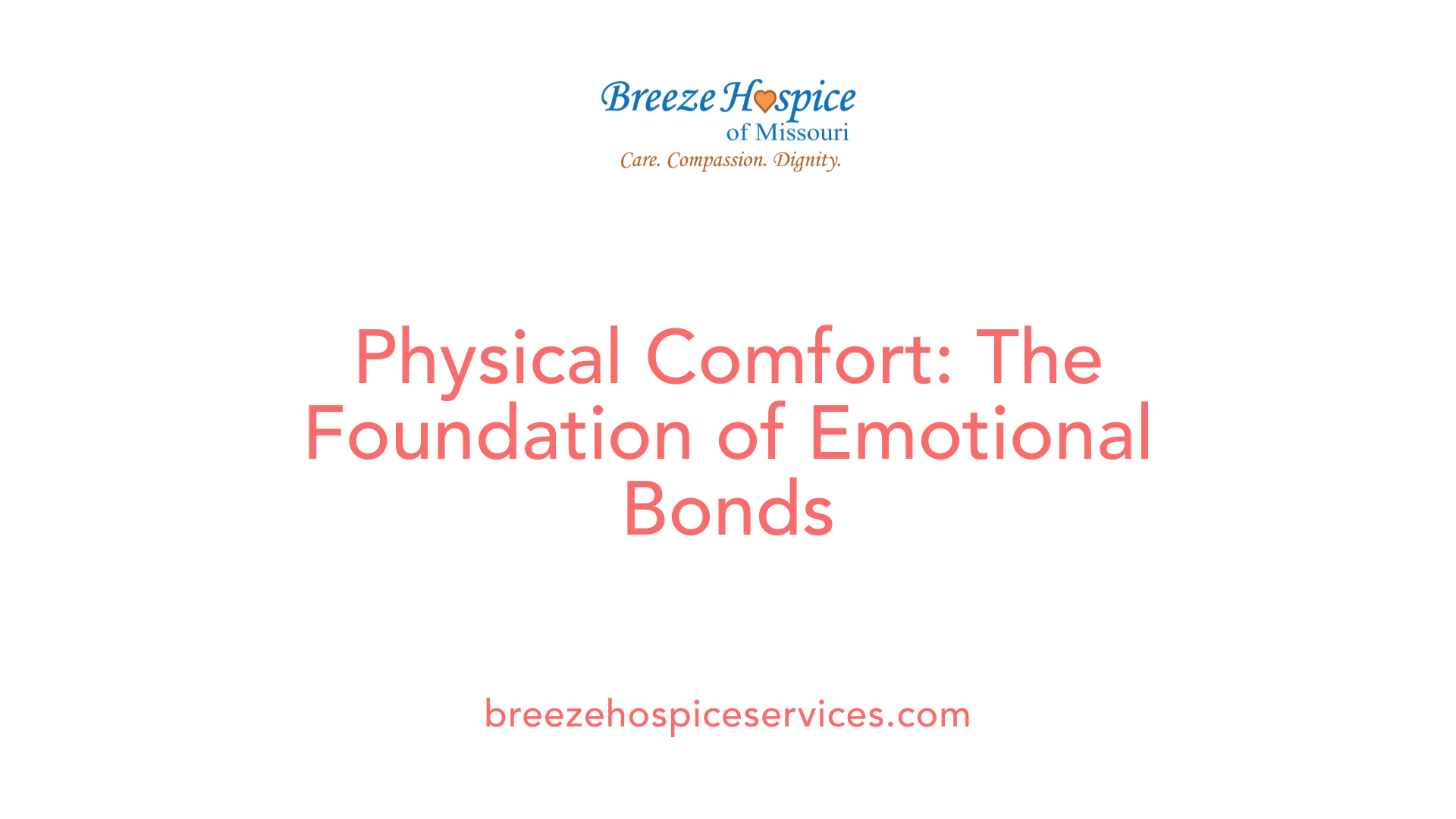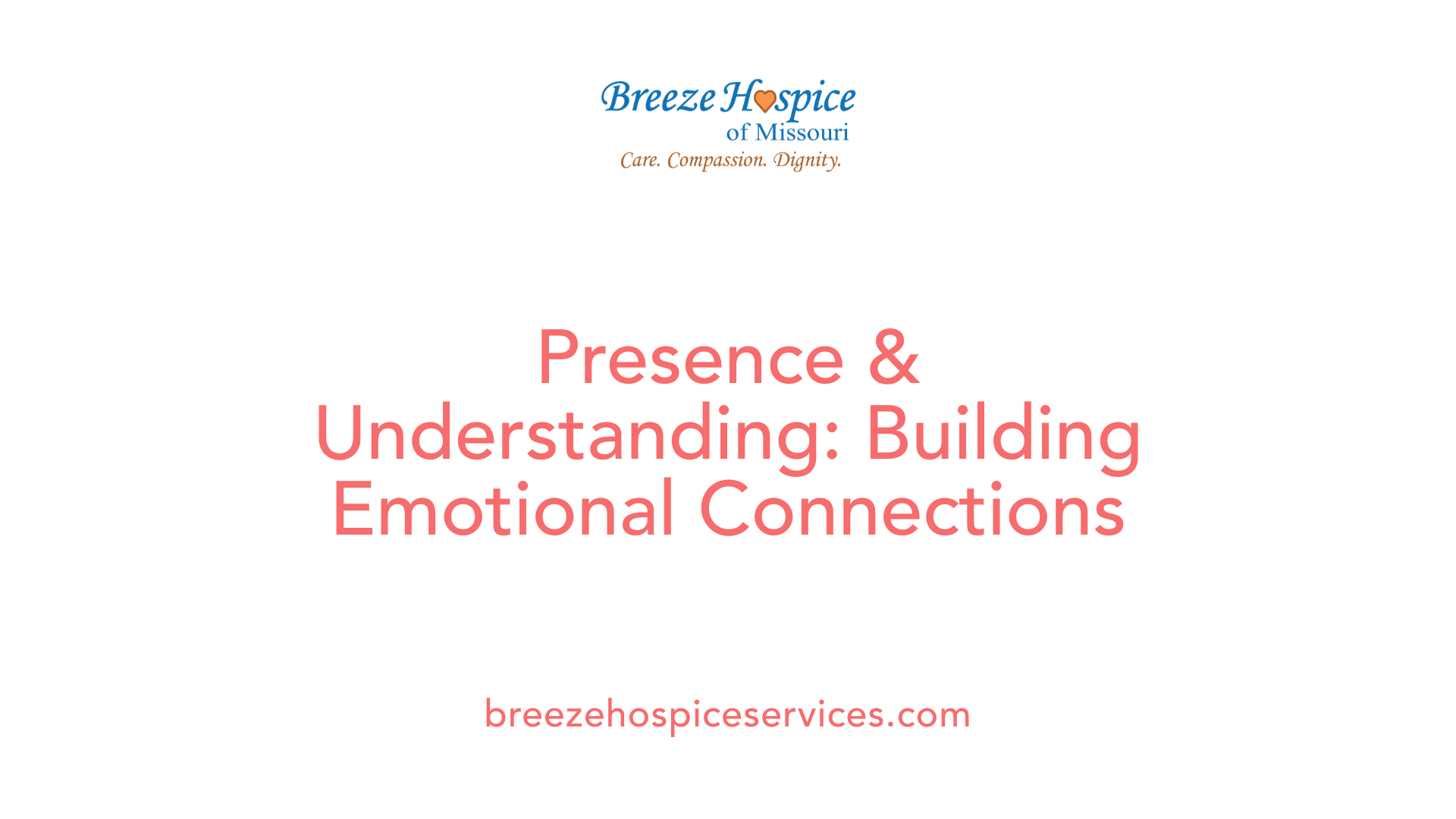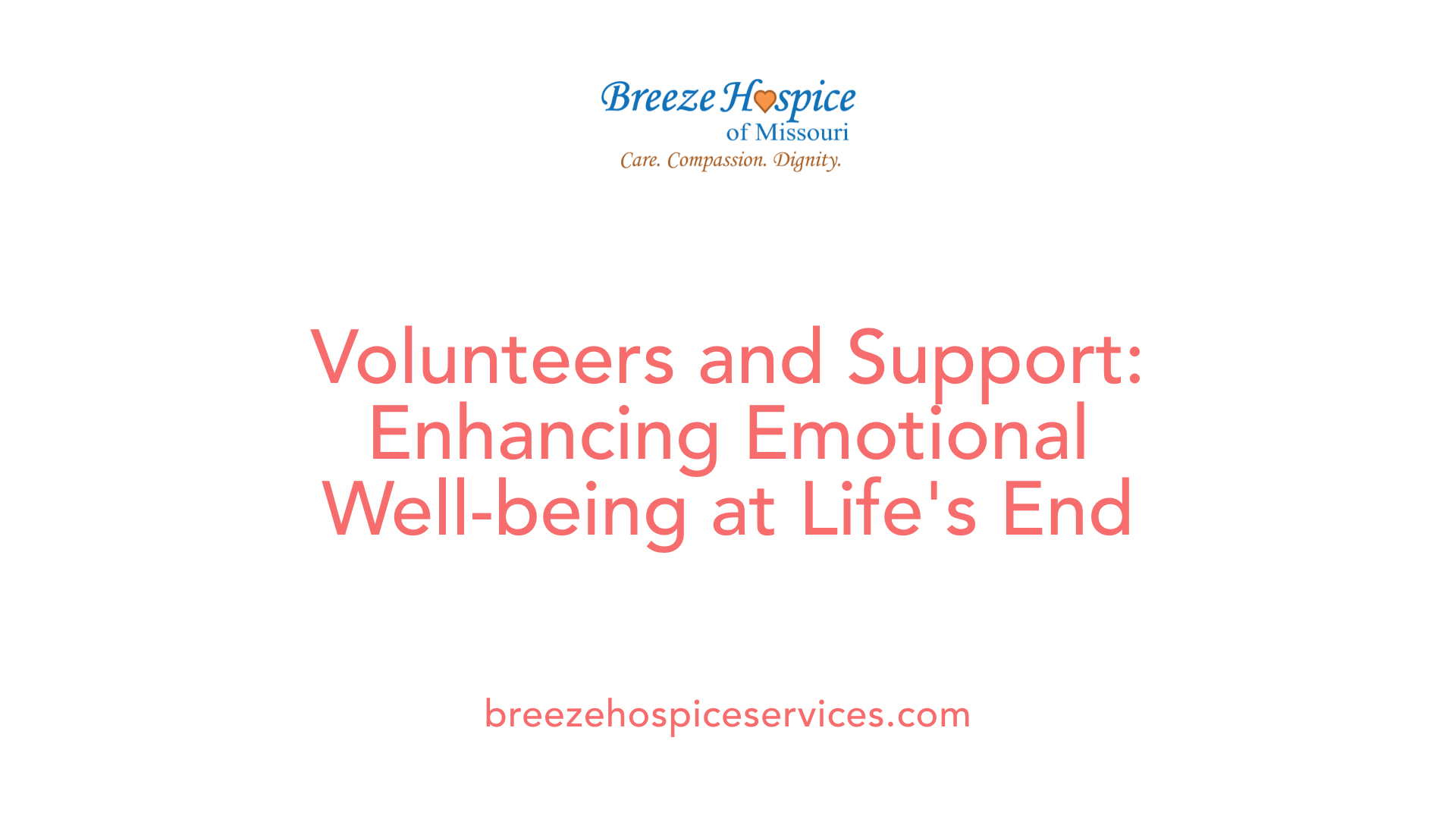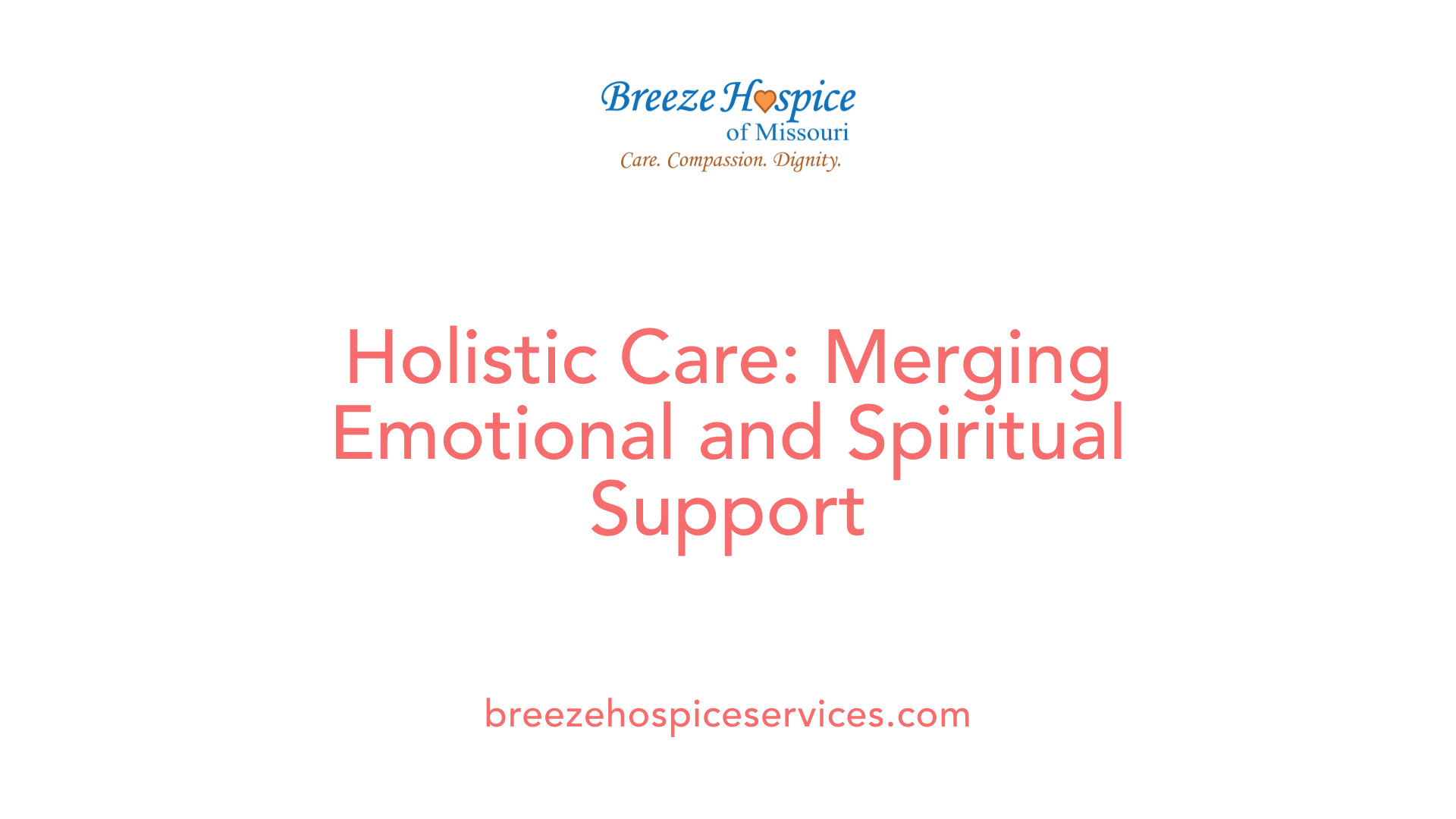How Bedside Assistance Provides Emotional Connection for Hospice Patients
July 21, 2025
Fostering Comfort and Connection at the End of Life

Understanding the Power of Bedside Assistance in Hospice Care
Hospice care prioritizes not only managing physical symptoms but also cultivating meaningful emotional connections that enhance patients' quality of life during their final days. Bedside assistance and compassionate presence serve as vital tools in establishing trust, alleviating fears, and providing psychological comfort. This article explores how bedside support—through empathetic engagement, holistic care approaches, and emotional presence—fosters deep connections between hospice providers and patients, ultimately promoting dignity, peace, and emotional well-being.
Physical Comfort and Its Role in Emotional Connection
 Hospice care prioritizes physical comfort as a foundation for fostering emotional bonds. Managing symptoms effectively allows patients to feel more secure and cared for, which is crucial during their final days.
Hospice care prioritizes physical comfort as a foundation for fostering emotional bonds. Managing symptoms effectively allows patients to feel more secure and cared for, which is crucial during their final days.
Pain relief and symptom management are central to this approach. Skilled healthcare teams employ a variety of treatments such as medication, holistic therapies, and environmental adjustments to minimize pain and discomfort. These efforts help patients preserve their dignity and improve their quality of life.
In addition, hospice services address specific physical issues, including relief from breathing problems like shortness of breath, skin irritation from pressure sores, digestive issues such as nausea, temperature sensitivity, and fatigue. These symptoms, if unmanaged, can cause significant distress, but comprehensive symptom management alleviates suffering and facilitates emotional stability.
Creating a comfortable environment not only eases physical discomfort but also signals care and empathy, reinforcing emotional bonds between patients, families, and caregivers.
How does hospice provide emotional support?
Hospice provides emotional support through a variety of services aimed at helping patients and their families cope with complex feelings such as fear, sadness, and anxiety. Professional counselors offer individual and group counseling to address emotional needs, while supportive environments foster open communication and active listening. Volunteer companionship, creative therapies like art and music, and spiritual support further promote emotional well-being. Additionally, hospice offers resources such as support groups, educational materials, and respite care to help families manage emotional challenges. Overall, hospice prioritizes creating a comforting, safe space where emotional pain can be acknowledged and addressed, enhancing quality of life for both patients and their loved ones.
What strategies are used in hospice care to build trust and emotional bonds with patients?
Hospice care employs a range of strategies to build trust and foster emotional bonds with patients, including active, empathetic listening, validation, and compassionate communication by healthcare providers such as nurses, social workers, and counselors. Regular emotional check-ins and personalized care plans that address patients' social, spiritual, and emotional needs help create a safe and supportive environment.
Techniques like positive emotion communication—such as humor, praise, and shared joy—enhance social bonds and resilience throughout the end-of-life process. Providing education about disease progression and care options empowers patients and families, strengthening confidence and trust. Additionally, offering supportive services such as counseling, grief support, life review activities, and practical assistance further deepens emotional connections and ensures holistic, person-centered care.
How do hospice providers foster emotional connection and support the psychological well-being of patients?
Hospice providers foster emotional connection and support patients' psychological well-being through compassionate communication techniques such as active listening, empathy, validation, and the use of positive emotion communication (PEC), including humor, praise, and savoring. They create a safe and personalized environment where patients and families feel comfortable expressing their feelings, share meaningful moments, and find joy despite the challenges of end-of-life.
Regular emotional check-ins, counseling, support groups, spiritual support, and legacy activities help patients maintain a sense of purpose, peace, and connection. Team members—including nurses, social workers, and counselors—develop rapport by attuning to patient needs and facilitating open, non-judgmental dialogue, while also addressing psychological and existential concerns.
Overall, hospice providers emphasize holistic care that nurtures emotional bonds, fosters resilience, and enhances quality of life for patients and their loved ones during this sensitive time.
What is the role of a caregiver in hospice care?
The role of a caregiver in hospice care is comprehensive and vital to ensuring the comfort, dignity, and well-being of the patient. Caregivers are responsible for providing companionship, managing household tasks, preparing meals, assisting with mobility and personal hygiene, and overseeing medication management. They also support emotional well-being, offer safety measures at home, and coordinate with hospice providers to develop customized care plans.
Additionally, caregivers may seek external support through respite care, volunteer services, and various financial assistance programs to help manage physical, emotional, and financial stresses. Ultimately, caregivers play a central role in delivering patient-centered, comfort-focused care while also navigating their own emotional and practical challenges.
How can nurses support patients and families emotionally during end-of-life care?
Nurses support patients and families by providing empathetic listening, reassurance, and guidance. They create a safe environment where patients feel heard and supported, helping to alleviate fears and anxiety. By engaging in open, honest conversations about illness progression and care preferences, nurses foster trust and understanding.
They also facilitate emotional expression, encourage family involvement, and connect patients with additional resources like counseling or spiritual support. Their presence offers comfort, comfort, and a sense of stability during a difficult transition.
Why is emotional connection important for quality of life in hospice settings?
Emotional connection significantly enhances the quality of life by providing psychological comfort, reducing feelings of loneliness and fear, and affirming patients' dignity. A trusting relationship with caregivers fosters a sense of safety and belonging, enabling patients to express feelings openly and find moments of joy.
Such connection helps patients cope with physical decline and existential concerns, leading to more peaceful, meaningful experiences at the end of life. It also supports families by offering reassurance and clarity, making the entire hospice journey more compassionate and respectful.
| Aspect | Approach | Description |
|---|---|---|
| Symptom Management | Pain relief, holistic therapies | Minimizing physical discomfort to enhance emotional stability |
| Emotional Support | Counseling, support groups, therapies | Addressing fears, sadness, and psychological needs |
| Trust Building | Empathy, active listening | Creating a safe environment for open communication |
| Physical Comfort | Environment adjustments, symptom control | Signaling care and fostering emotional bonds |
| Family Support | Guidance, respite, grief counseling | Supporting caregivers and family members |
| Presence and Connection | Bedside visits, shared activities | Establishing ongoing emotional bonds |
The Significance of Presence and Mutual Understanding in Emotional Bonding

Being alongside the patient—physical presence, family, and friends
A fundamental aspect of emotional connection in hospice care is the physical presence of caregivers, family members, and friends. Being there for the patient provides more than just physical comfort; it offers reassurance and psychological support that help the patient feel valued and understood during their final days.
Regular visits and heartfelt moments foster a sense of companionship, reducing feelings of loneliness and fear. Creating an environment where patients feel safe and emotionally supported encourages open communication about their needs and fears.
Addressing spiritual needs through religious practices and conversations about life and death
Spiritual comfort plays a vital role in emotional bonding. Facilitating religious practices, prayers, or spiritual conversations helps patients find peace and meaning as they face end-of-life decisions. These interactions often involve chaplains or spiritual counselors who support patients in exploring their spirituality, discussing life’s big questions, and expressing hopes or fears about death.
Encouraging reflection, legacy writing, or sharing stories allows patients to connect with their spiritual beliefs and feel a continued sense of purpose. Respectful conversations about life and death help patients and families navigate complex emotions with dignity.
Achieving mutual understanding and realistic information sharing
Effective communication is crucial for building trust and emotional bonds. Offering honest, yet compassionate, information about the patient’s condition helps them grasp their circumstances and participate in care decisions.
Acceptance of the clinical situation, combined with attentive listening and emotional responsiveness, fosters a mutual understanding. Caregivers who demonstrate empathy and provide realistic expectations reassure patients, easing anxiety and fostering peace.
This approach ensures that both patients and loved ones feel heard and supported, which is essential for emotional resilience and acceptance during this sensitive phase.
| Approach | Main Focus | Impact | Additional Details |
|---|---|---|---|
| Being alongside | Physical and emotional presence | Psychological support and reassurance | Regular visitation, shared activities, family involvement |
| Spiritual conversations | Religious practices and life review | Emotional peace and meaning | Chaplain visits, prayer, legacy work |
| Clear communication | Honest sharing of information | Trust and reduced fear | Compassionate disclosure, active listening |
Tactile and Sensory Engagement for Emotional Comfort
 Creating meaningful and comforting interactions at the bedside is essential for supporting hospice patients emotionally. One of the most effective ways to foster a sense of connection and reassurance is through tactile and sensory engagement.
Creating meaningful and comforting interactions at the bedside is essential for supporting hospice patients emotionally. One of the most effective ways to foster a sense of connection and reassurance is through tactile and sensory engagement.
Connecting with hospice patients through touch, voice, music, and familiar objects can significantly help satisfy their emotional needs. When patients are unable to communicate verbally, these sensory methods help bridge the gap, making them feel seen and cared for. Gentle touches, holding their hand, or softly speaking can convey compassion and presence.
Music and familiar objects play a vital role as well. Playing soothing music, sharing favorite songs, or bringing in personal keepsakes can evoke memories and feelings of safety and warmth. Such approaches help patients feel connected to their identity and loved ones.
To promote dignity and emotional well-being, caregivers often use imagery and sensory experiences. Reading aloud from a favorite book, reciting poetry, or reminiscing about meaningful life events encourages positive emotional states. These activities can evoke joy, nostalgia, and serenity, helping patients find peace in their final moments.
Incorporating these sensory strategies into care routines enhances the emotional environment of hospice settings. They promote comfort, foster emotional bonds, and uphold the dignity of patients, making their experience at the end of life as meaningful and tranquil as possible.
The Role of Volunteers and Support Systems in Enhancing Emotional Well-being
 Volunteers play a vital part in hospice care by providing much-needed companionship and emotional support to patients facing the final stages of life. Their presence helps to ease feelings of loneliness, fear, and anxiety, creating a tranquil environment where patients feel seen and cared for.
Volunteers play a vital part in hospice care by providing much-needed companionship and emotional support to patients facing the final stages of life. Their presence helps to ease feelings of loneliness, fear, and anxiety, creating a tranquil environment where patients feel seen and cared for.
Engaging in comforting activities such as reading aloud, sharing stories, or organizing gentle outings allows volunteers to foster meaningful emotional bonds. These interactions promote a sense of purpose and joy, helping patients maintain dignity and emotional well-being.
In addition to supporting patients, volunteers also offer essential respite for family caregivers. By providing short-term relief, they enable family members to rest, attend to personal needs, or manage other responsibilities, which helps prevent burnout and exhaustion.
During the final hours of a patient's life, volunteers remain at their bedside, offering silent companionship and reassurance. This presence can be profoundly comforting, ensuring that patients do not feel alone in their last moments.
Volunteers also extend their support to families after a loved one's passing. Through condolence outreach, participation in grief groups, and memorial services, they help families process their grief and continue to feel connected to their loved ones.
Their involvement enhances the emotional landscape of hospice care, fostering healing and resilience for both patients and their families. While volunteers are a cornerstone of emotional support, their roles are carefully defined, as they do not undertake medical or clinical tasks. Instead, they serve as respectful, heartfelt companions, enriching the holistic approach to end-of-life care.
In summary, the dedicated efforts of volunteers support emotional well-being through compassionate presence and kindness, bridging the physical and emotional needs during life's final journey.
Integrating Emotional and Spiritual Support into Holistic Care

What kinds of emotional support are provided in hospice care?
Hospice care offers a variety of emotional support options tailored to each patient's needs. These include one-on-one counseling sessions, group therapy, and spiritual guidance. Such services help patients process their feelings, manage fears, and find peace during their final days.
How do hospice teams support psychological and spiritual well-being?
Hospice teams consist of social workers, spiritual counselors, volunteers, and healthcare professionals dedicated to supporting both the emotional and spiritual health of patients and their families. They encourage meaningful conversations about fears, hopes, and life legacies.
These teams facilitate legacy projects like journaling and memory boxes, which help preserve personal stories. They also address spiritual needs through tailored practices and conversations about life and death.
Counseling and therapy sessions help patients cope with anticipatory grief and complex family decisions, providing reassurance and guidance needed to navigate emotional challenges.
How does holistic care address the needs beyond the physical?
Holistic hospice care emphasizes creating a supportive environment through active listening and empathy. This approach allows patients to openly express fears and concerns without judgment.
Integrative therapies such as pet therapy and music therapy serve as additional tools to help patients process emotions, foster serenity, and maintain dignity. These practices contribute significantly to emotional well-being, supporting patients in achieving a sense of peace.
Hospice's comprehensive model ensures that emotional and spiritual needs are met alongside physical comfort, promoting a well-rounded method of compassionate care for those at the end of life.
The Power of Compassionate Bedside Support
Through compassionate bedside assistance, hospice providers create a nurturing environment where emotional bonds flourish. By combining physical presence, personalized communication, sensory engagement, volunteer companionship, and holistic support, caregivers foster trust, understanding, and emotional resilience. These connections are essential in alleviating suffering, promoting dignity, and ensuring that patients experience comfort, peace, and meaningful moments at the end of life. Ultimately, the profound human interactions facilitated by bedside assistance underscore the core mission of hospice—to provide end-of-life care that is as emotionally rich and supportive as it is physically compassionate.
References
- Providing Care and Comfort at the End of Life
- Emotional Bond: The Nature of Relationship in Palliative Care for ...
- How We Provide Emotional Support for Hospice Patients - 3HC
- The Importance of Empathy in End-of-Life Care in Portland, OR
- Exploring a Fulfilling Hospice Care Career
- End-of-Life Care: Caregiving in the Late Stages of Life - HelpGuide.org
- The Benefits of Volunteer Work in Hospice Care? | Springfield, MO
- Volunteer Services for Patients - Dallas - Angel Hands Hospice
- Benefits of Hospice Care
- What Are Ways to Promote Emotional Well-Being in Hospice Patients?



































































































